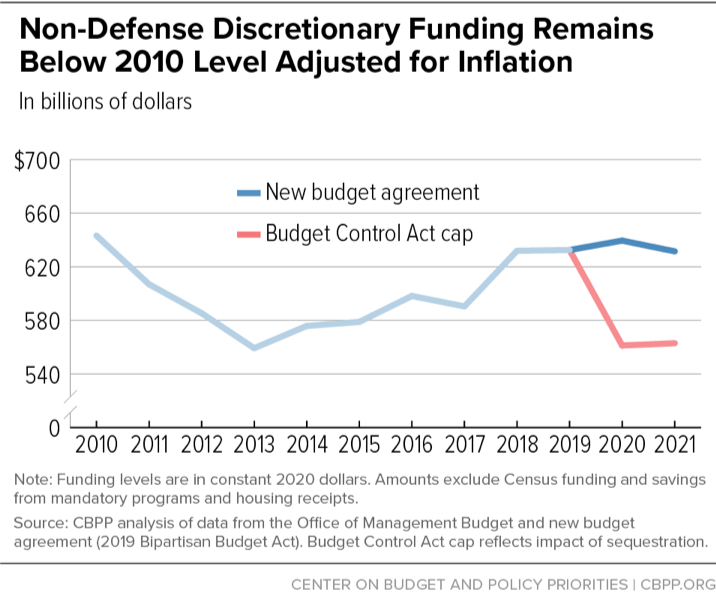BEYOND THE NUMBERS
The budget deal’s boost in non-defense discretionary (NDD) funding will only maintain NDD at about its 2019 level for the next two years, after adjusting for inflation, and won’t return NDD to its level of 2010. Claims that the deal provides very large NDD increases are true only when it’s measured against the 2011 Budget Control Act’s (BCA) very low sequestration-reduced funding targets, which policymakers have consistently overridden, acknowledging that they’re too low to meet national needs.
NDD funding covers about one-sixth of the budget, including elementary education, transportation, national parks and environmental protection, law enforcement, veterans’ health care, medical and other scientific research, housing assistance, tax collection, and international diplomacy, among many other areas. These programs are called “discretionary” because policymakers have the legal discretion to decide their funding levels each year through the appropriations process. (In contrast, funding levels for “mandatory” programs such as Social Security are generally determined by the benefit levels mandated by law and the number of people enrolled in them.)
The 2010 level is an appropriate comparison point for evaluating NDD funding under the new budget agreement. That’s because it’s the last year before policymakers started cutting discretionary funding, mainly through the BCA, which imposed stringent annual caps on defense and non-defense funding through 2021. And the 2010 appropriations bills did not contain stimulus funding to address the Great Recession; the discretionary stimulus funding was provided as part of the 2009 Recovery Act (even though some of it wasn’t spent until after 2009). The graph above shows NDD funding levels for all years since 2010.
To make the funding levels for these years as comparable as possible, we made certain adjustments. First, we removed Census Bureau funding in all years to avoid any distortions created by the 2010 census or the funding increases needed to prepare for the 2020 census. Second, we removed the savings from mortgage insurance program receipts and provisions of appropriations bills that reduced funding for some mandatory programs. By removing these savings, we are showing gross funding, which better represents NDD policy.
That NDD funding has almost but not entirely returned to the inflation-adjusted 2010 level doesn’t mean that we’ve erased all of the harm from the deep cuts from 2011 to 2017. Those cuts, which totaled roughly $450 billion relative to continuing the 2010 level adjusted for inflation, deepened the backlog of unmet needs in areas such as infrastructure and air and water quality. And the harm from other cuts is hard if not impossible to reverse, such as the lack of adequate child care or early education for many children during that period.
Moreover, when measured as a share of the economy, NDD funding under the budget deal will be significantly below the 2010 level and near historic lows. In essence, the deal will prevent the steep cuts that were planned in 2011 for the next two years, not provide some new funding windfall.

